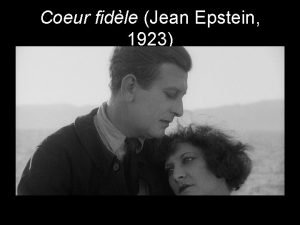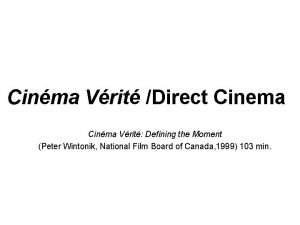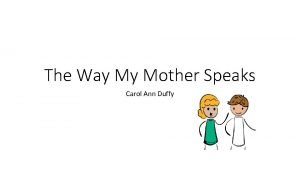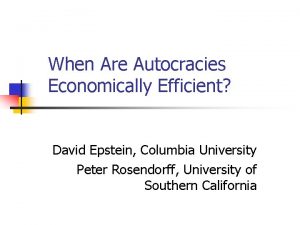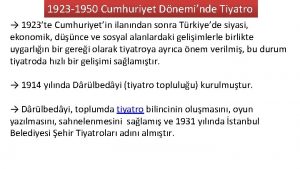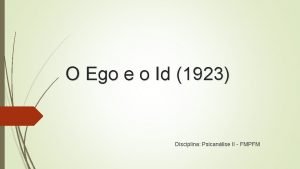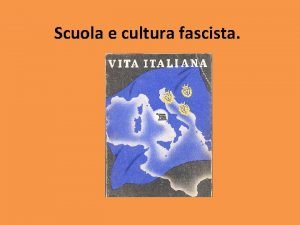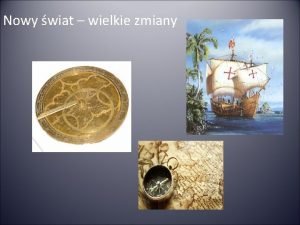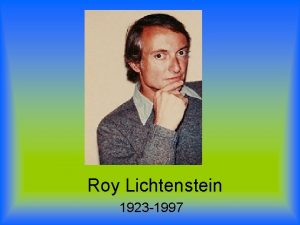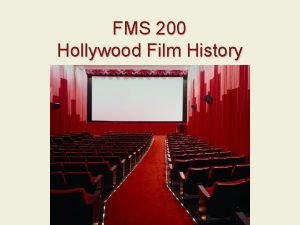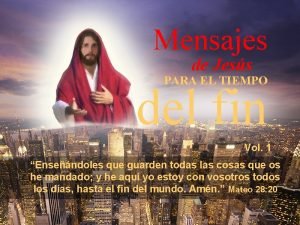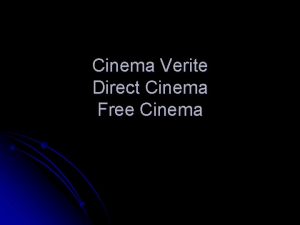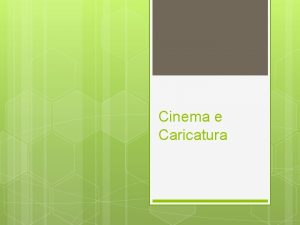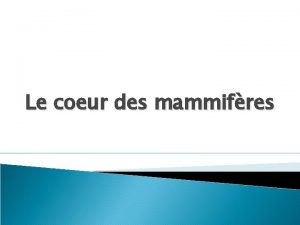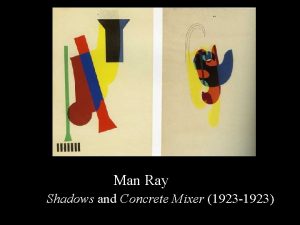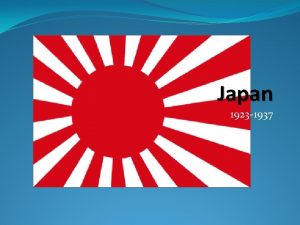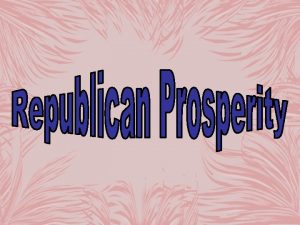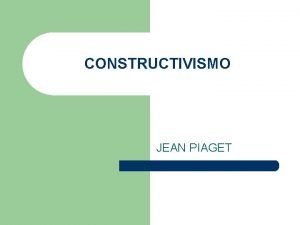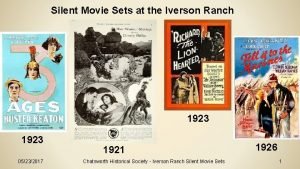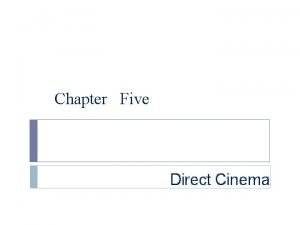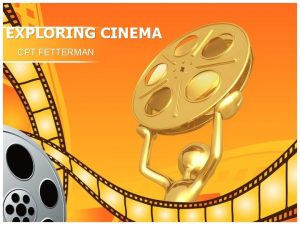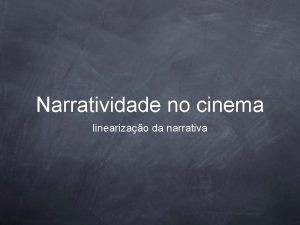Coeur fidle Jean Epstein 1923 Studying silent cinema



















- Slides: 19

Coeur fidèle (Jean Epstein, 1923)

Studying silent cinema Things to consider: • narrative structure • frontal framing • performance style • silent film sound ‘Imaginons ce monde de bruits: port, cafés, vagues, fête, cris, frappement, jusqu’au coup de feu final. Il faut voir Coeur fidèle comme un film où le son déborde, comme un grand film sonore. ’ (Hillairet, p. 55)

Cinema in the 1920 s: Hollywood and France • Hollywood dominated the global film industry through its vertically-integrated studio system. • The basis of the Hollywood continuity style was put in place. • The French film industry was comparatively small: fewer than 100 films per year compared to 600 US; $30 000 - $40 000 budget per film compared to $350 000 US. • French industry dominated by small production companies. • More use of location shooting and natural light in France. • Did this industrial structure facilitate the development of an avant-garde in France?

The first avant-garde in French cinema: Impressionism • A film movement more interested in pictorial beauty and psychological explanation than narrative drama. • Practitioners published theory in books and journals; films were often self-financed or independently produced. • Louis Delluc, Germaine Dulac, Jean Epstein, Jacques Feyder, Abel Gance, Marcel L’Herbier

Louis Delluc (1890 -1924) One of the first serious film critics and theorists in France, Delluc argued for: • Film directors to be considered as creative artists; • Individual films to be given a dedicated time slot in cinemas; • The preservation and repeat screening of superior films. He pioneered: • Regular film review columns in the daily and weekly press; • France’s first serious film journals: Le Journal du Ciné-Club and Cinéa. ‘This broadly sustained development of independent cinema journals and an embryonic film theory/criticism were unique to France. Nothing much like this existed in the United States or Germany, let alone in Great Britain, Italy, or the Scandinavian countries. ’ (Abel, p. 251)

Film culture in France in the 1920 s • First film club, Le Club des Amis du Septième Art, created by Ricciotto Canudo. • Public lectures on film theory, history and style. • Creation of specialist art cinemas Le Théâtre du Vieux Colombier and the Studio des Ursulines

Impressionism in the cinema • ‘Art does not yield truth; instead, it creates an experience, and that experience leads to emotions for the spectator. Art creates these feelings not by making direct statements but by evoking or suggesting them. In short, artworks create fleeting feelings, or impressions. ’ (Thompson and Bordwell, p. 92) • Visual devices used to convey ‘impressions’ i. e. feelings, thoughts, ideas: superimposition, blurring, distorting mirrors, slow motion, unusual framing…

Techniques of impressionist cinema 1) Camerawork Use of close-ups and synecdoches and symbols • Use of close-ups as subjective images • Use of camera angles to indicate optical subjectivity • Camera movement independent of the subject • Camera movement for purely graphic effects • Camera movement representing a character’s point of view • 2) Mise-en-scène Single light source • Shadows indicating off-screen actions • Variety of lighting situations • Variety of décor styles, usually undistorted and naturalistic Some interplay of foreground and background arrangement and movement of figures in space

Techniques of impressionist cinema, continued • • • 3) Optical devices As transitions As magical effects As emphasizing significant details As pictorial decoration As conveyers of abstract meanings As indications of subjectivity 4) Editing Temporal relations between shots: Flashbacks or fantasy Spatial relations: Occasional synthetic building up of space from specific detail • Glance-object editing • Crosscutting • Rhythmic relations between shots: • To convey psychological and physiological states. • • • (Bordwell [1974], quoted in Abel, p. 288)

La photogénie • ‘a total relation between pro-filmic reality, what stands in front of the camera, filmic images, and the embodied viewer’ (Wall. Romana, 26). • ‘cucul-praline-rhododendron’! (Blaise Cendrars, quoted in Wall-Romana, 25). • ‘First, photogénie is a hyper-aesthetic phenomenon, that is, a heightened mode of viewing through which things and beings animated by film appear more intense to perceivers. Second, photogénie involves some kind of emotional response by the perceiver to this heightened mode of appearance, relatively independently from the contents of film images themselves. Third, […] temporality and the virtuality of something to come, as well as some kind of interpersonality […] organize the force -field of the movie-viewing experience. ’ (Wall-Romana, p. 27).

Cinema in relation to the other arts • Cinema has spatial qualities, like painting, sculpture or architecture • but also temporal qualities like music, dance and poetry. • Filmmakers stressed ‘visual rhythm’ e. g. Abel Gance in La Roue (1923)

The end of impressionism By the late 1920 s: • ‘impressionist’ techniques had become relatively commonplace; • Surrealism was making more radically confrontational avantgarde films; • The arrival of sound drove up the cost of filmmaking; • Some considered the era of cinematic creativity to be over.

Jean Epstein (1897 -1953) • An important early film theorist and experimental filmmaker but books and films unavailable until very recently • Born in Poland raised in Switzerland

Jean Epstein • He wrote several books about cinema and modern literature • An exile, a Jew and a homosexual, he lived with his sister Marie for much of his life

Reactions to Coeur fidèle • • • ‘Nous n’assistons pas à un spectacle de foire sur l’écran. Nous y participons. ’ (Les 2 arts, qtd in Hillairet, p. 33) ‘Les gens n’étaient pas habitués à cette mobilité: ils ne pouvaient pas comprendre. Des personnes disaient que ça leur donnait mal au coeur. ’ (Epstein, qtd in Hillairet, p. 83). ‘Est-ce qu’il y a encore beaucoup de ces chevaux de bois? . . . Parce que je vais être obligé d’appeler la police’ (Alleged words of a distributor to Epstein, qtd in Hillairet, p. 84)

Melodrama ‘we can think of Epstein’s particular position in the early 1920 s as one attempting to combine avant-garde aesthetics with working-class melodrama to craft a new form of social realism’ (Wall-Romana, p. 51).

Narrative versus sensation • ‘Affect at its most sensorial clearly takes centre stage over plot, pity, and even the imperative of expressing the protagonists’ excessive emotions as such. ’ (Wall. Romana, pp. 58 -9) • ‘Il n’y a pas d’histoire. Il n’y a jamais eu d’histoire. Il n’y a que des situations […] Je désire des films où il ne se passe non rien, mais pas grand-chose’ (Epstein, qtd in Hillairet, p. 32).

‘L’amoureux du bord des eaux’ Thematic parallels in French cinema: Lovers by the water: • L’Homme du large (Marcel L’herbier, 1920) • Boudu sauvé des eaux (Jean Renoir, 1932) • L’Atalante (Jean Vigo, 1934) • Partie de campagne (Jean Renoir, 1936) Port films: En rade (Alberto Cavalcanti, 1928) Remorques (Jean Grémillon, 1941)

Bibliography • Abel, Richard, French Cinema: The First Wave, 19151929 (Princeton: Princeton University Press, 1984). • Hillairet, Prosper, Coeur fidèle de Jean Epstein (Crisnée: Yellow Now, 2008). • Thompson, Kristin and David Bordwell, Film History: An Introduction (New York: Mc. Graw-Hill, 1994). • Wall-Romana, Christophe Jean Epstein: Corporeal Cinema and Film Philosophy (Manchester: Manchester University Press, 2013).
 Wall-romana jean epstein download
Wall-romana jean epstein download Direct cinema vs cinema verite
Direct cinema vs cinema verite The way my mother speaks past paper
The way my mother speaks past paper Eric epstein md
Eric epstein md Modelo centrado en la tarea
Modelo centrado en la tarea Daniel epstein rosario
Daniel epstein rosario David epstein columbia
David epstein columbia Epsteins model
Epsteins model Cumhuriyet dönemi'nde tiyatro 1923 1950
Cumhuriyet dönemi'nde tiyatro 1923 1950 O ego e o id (1923 resumo)
O ego e o id (1923 resumo) Nein mich zwingt ihr nicht
Nein mich zwingt ihr nicht Ruhr crisis 1923
Ruhr crisis 1923 Riforma gentile 1923
Riforma gentile 1923 Henryk żeglarz ur 1923
Henryk żeglarz ur 1923 Roy lichtenstein (1923-1997)
Roy lichtenstein (1923-1997) Hollywoodland 1923 larry
Hollywoodland 1923 larry Lei eloy chaves 1923
Lei eloy chaves 1923 Con dios todo es posible
Con dios todo es posible 1923cmp
1923cmp Auto dealer compliance training
Auto dealer compliance training
